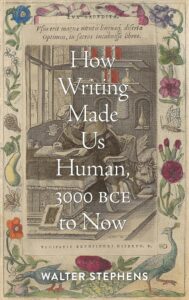How Writing Made Us: 3000 BCE to Now – Walter Stephens
 How Writing Made Us Human: 3000 BCE to Now. By Walter Stephens. (Baltimore: Johns Hopkins University Press, 2023. 532pp. Cloth, $39.95.)
How Writing Made Us Human: 3000 BCE to Now. By Walter Stephens. (Baltimore: Johns Hopkins University Press, 2023. 532pp. Cloth, $39.95.)
During graduate school, I took a course on the history of technology in society. This class was not concerned with more the more “technical” aspects of technology, like engineering for example. Rather it was interested in technologies as systems and artifacts and the way they interacted with culture and society, and how they evolved over time. We also talked about “failed” technologies, like the Supersonic Transport (SST). It was an interesting class and was valuable as I moved forward in my own studies of technology and space colonies.
In How Writing Made Us Human, writing is clearly a technology based on Kranzberg’s six laws of technology, and when Stephens tries to draw the line between the “technical” aspects of writing and what he deems the emotional development and impact of writing on writing, he begins to slip and lose his focus. According to Kranzberg, technologies encompass all facets of that technology’s definition; not just technical details, but how technologies interact with society and culture as well. Stephens, as mentions, claims he is not writing a technical history, meaning engineering in a very simplified term, but he also writes about writing as a technology in a sociocultural way, even if he doesn’t intend it (Stephens, xiii). Technology, according to Kranzberg, applies to both facets of an artifact and/or process. You can’t separate one from the other. Stephens claims to be writing an emotional history of writing, which Kranzberg would say again is part of the wholistic artifact and process (Stephens, xii).
It may be helpful to recap Kranzberg’s six laws*:
- Technology is neither good nor bad; nor is it neutral (545).
- Invention is the mother of necessity (548).
- Technology comes in packages (549).
- Although technology might be a prime element in many public issues, nontechnical factors take precedence (550).
- All history is relevant, but the history of technology is most relevant (553).
- Technology is a very human activity and so is the history of technology (557).
To me, writing meets all this criteria as both and artifact and a process. I don’t think you can elide one aspect of writing when naming writing a technology. What you can try to do is say you’re going to focus on one aspect that of that technology, as long as you acknowledge the wholistic process/artifact.
This is something Stephens does in the Preface, and it should cover his bases, but the difficulty is that definitions of technology can be sloppy, and in is book he slides between one side and other because it can be hard to separate all the components when they rely so heavily on each other.
He is writing a history of the history of writing, a historiography of writing, and this means he explores writing to the very beginning of the technology, tracing its evolution over time (this is technology bit) as seen through what his historical actors wrote about the history of writing, or how they developed their own histories of writing (Stephens, xii). I was impressed that he was able to trace this trend as far back as 3000 BCE. I never thought that people would have begun writing about writing from the very onset of the technology. Through this history, Stephens’ historical actors explore and reify their own mythological or historical experiences. I would never thought of using mythology as a way to understand the history of writing. Those were my favorite chapters in the book.
At the end of the day, I am not sure how I feel about Stephens’ argument. I am too caught up over the debate about what technology is and what constitutes it, and I am confused by Stephens’ desire to compartmentalize a complicated set of interactions. Writing about the history of writing and the history of the history of writing are separated only by degrees. You really can’t do one without the other. This was also a rather top down history, which I am not criticizing – to incorporate more points of view would have made this study impossible. But it does leave the door open for others wanting to explore the vernacular, or different socioeconomic class responses to writing, or how writing’s role in culture changed after the invention of the printing press. I was disappointed there wasn’t more on the printing press in this book. It added to the technology in writing; Kranzberg would argue that the technology of writing necessitated the invention of the printing press, and the printing press was part of a technological package, a technological subset of the technology of writing.
This was an interesting book, and I learned a lot of about the role writing played in the West from 3000 BCE to present (though the chapters became more condensed as Stephens moved forward in the timeline, perhaps a reflection of how difficult it is to create a general survey about how widespread and differentiated writing has become as we move from the religious elites to a vast popular audience, not to mention word processors and the internet). If I was a professor of a history of technology in society class, I would definitely assign this book, as I think it raises a lot of important questions about the nature of technology and how we study it. Its shortcomings or confusion is what make this book a valuable tool for teaching and learning. And it still has a lot of good things to teach us about how people have thought about writing over time.
